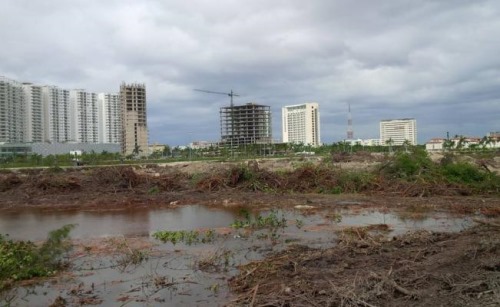Environmentalists are denouncing the recent overnight destruction of mangroves in the Malecón Tajamar area of Cancún. Malecón Tajamar is a tourist complex with infrastructure financed by Mexico’s federal tourism development agency Fonatur, which has form when it comes to environmental destruction. (See, for example, Conflict at Cabo Pulmo: mass tourism meets ecotourism.)
Mexico is one of the world’s wealthiest countries in terms of mangroves, with between 600,000 and 900,000 hectares of them in total. (For details about why this range of values is so large, see How fast are mangroves disappearing in Mexico?) To prevent further destruction Mexico enacted federal legislation in 2007 designed to protect existing mangroves.
Despite this, news reports indicate that heavy equipment, protected by armed police, moved in to Malecón Tajamar on 16 January 2016 and proceeded to destroyed 57 hectares (140 acres) of mangroves overnight. This mangrove swamp had been under threat for some time, but the activist movement “Salvemos Manglar Tajamar” had gained considerable public support and managed to bring a temporary halt to further development work in the area.
Greenpeace México alleges that Fonatur falsified environmental assessments, and even denied that any mangroves existed at Malecón Tajamar. According to Greenpeace, municipal, state and federal authorities colluded to ensure that the mangroves would be destroyed and that construction of the tourist complex could continue.
Activists claim that the distinctive and ecologically-important mangrove habitat was home to crocodiles, iguanas, birds and snakes, and that the ecosystem services (fishing, coastal protection, habitat for other species, carbon sequestration, etc) provided by a healthy mangrove swamp outweighed all other options. (For more details, see How valuable are Mexico’s mangrove swamps?)
Greenpeace México not only condemned the destruction of mangroves but called for an immediate halt to work in the area pending a full and open discussion with all stakeholders. They believe that the mangroves could possibly reestablish themselves in time if the area is left untouched.
Work to infill the area cleared of mangroves has now been suspended while animal experts try to rescue, and relocate, as many of the animals who survived the initial disturbance as possible. In theory, Fonatur and the federal Environmental Secreatariat were obligated to ensure that developers had an adequate plan in place, prior to clearance, to relocate all animals, in line with the initial environmental impact report approved in 2005.
Another NGO, Defensores del Manglar, has announced it will submit a formal complaint about recent events at Malecón Tajamar to the headquarters of the Ramsar Convention in Switzerland. The Ramsar Convention, to which Mexico is a signatory, is an international accord for the conservation and sustainable use of wetlands. Defensores del Manglar claims that Malecón Tajamar is protected under the Convention, even though the area does not appear to be specifically included on this list of Mexico’s 140+ Ramsar sites.
Geo-Mexico joins with Greenpeace Mexico and Defensores del Manglar in deploring the destruction of Mexico’s remaining mangroves and will continue to publicize cases where developer greed results in irreversible environmental damage.
Related posts:


Sorry, the comment form is closed at this time.